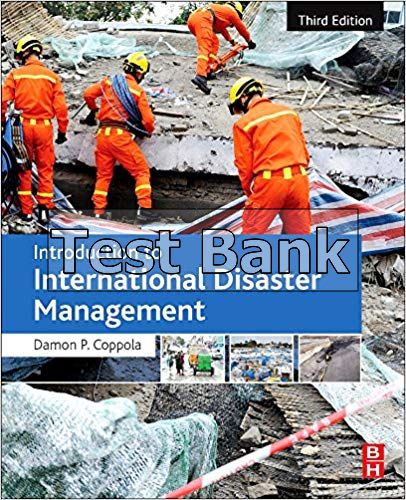Introduction to International Disaster Management 3rd Edition Coppola Test Bank
$26.50$50.00 (-47%)
Introduction to International Disaster Management 3rd Edition Coppola Test Bank.
You may also like
This is completed downloadable of Introduction to International Disaster Management 3rd Edition Coppola Test Bank

Product Details:
- ISBN-10 : 9780128014776
- ISBN-13 : 978-0128014776
- Author:
Introduction to International Disaster Management, Third Edition, continues to serve as the leading comprehensive overview of global emergency management. This edition provides practitioners and students alike with a comprehensive understanding of the disaster management profession by utilizing a global perspective and including the different sources of risk and vulnerability, the systems that exist to manage hazard risk, and the many different stakeholders involved. This update examines the impact of many recent large-scale and catastrophic disaster events on countries and communities, as well as their influence on disaster risk reduction efforts worldwide. It also expands coverage of small-island developing states (SIDS) and explores the achievements of the United Nations Hyogo Framework for Action (2005–2015) and the priorities for action in the Post-2015 Framework for Disaster Risk Reduction currently under development. This useful, relevant text includes many changes that have occurred since the last edition for a better understanding of the rapidly advancing field of international disaster management.
Table of Content:
- Chapter 1. The Management of Disasters
- Introduction
- Disasters Throughout History
- The History of Disaster Management
- Capacity by Demand: The 1970s and ‘80s
- The UN International Strategy for Disaster Reduction
- The Hyogo Framework for Action (HFA)
- The Post-2015 Framework
- Modern Disaster Management – A Four-Phase Approach
- What is International Disaster Management?
- Disasters, Poverty, and Development
- Disaster Trends
- Definitions
- Conclusion
- Chapter 2. Hazards
- Introduction
- Hazard Identification and Hazard Profiling
- Hazard Analysis
- The Hazards
- Conclusion
- Chapter 3. Risk and Vulnerability
- Introduction
- Two Components Of Risk
- Trends
- Computing Likelihood and Consequence Values
- Risk Evaluation
- Vulnerability
- Conclusion
- Chapter 4. Mitigation
- Introduction
- What is Mitigation?
- Types of Mitigation: Structural and Nonstructural
- Obstacles to Mitigation
- Assessing and Selecting Mitigation Options
- Emergency Response Capacity as a Risk Mitigation Measure
- Incorporating Mitigation into Development and Relief Projects
- Conclusion
- Chapter 5. Preparedness
- Introduction
- Overview of Disaster Preparedness
- Government Preparedness
- Public Preparedness
- The Media as a Public Educator
- Obstacles to Effective Public Education and Preparedness
- Conclusion
- Chapter 6. Response
- Introduction
- What is Response?
- Response – The Emergency
- Recognition—Pre-Disaster Actions
- Recognition—Post-Disaster
- Provision of Water, Food, and Shelter
- Volunteer Management
- Command, Control, And Coordination
- Conclusion
- Chapter 7. Recovery
- Introduction
- Overview of Recovery
- The Effects of Disasters on Society
- Pre-Disaster Recovery Actions
- Components of Recovery – What is Needed and where it Comes from
- Types of Recovery
- Special Considerations in Recovery
- Conclusion
- Chapter 8. Participants – Governmental Disaster Management Agencies
- Introduction
- Governmental Emergency Management Structures
- Governmental Disaster Management Agencies
- Organizational Structures
- Bilateral Disaster Management Assistance
- How Governments Provide Assistance
- Types of Bilateral Assistance
- Types of National Government Agencies Involved in International Disaster Management
- The Political Implications of Bilateral Disaster Assistance
- Collateral Impacts of Humanitarian Aid
- Conclusion
- Chapter 9. Participants – Non-Governmental Organizations, Including the Private Sector and Academia
- Introduction
- Who are the NGOs?
- What do They do?
- NGO Operations
- Aid Worker Safety and Security
- NGO/Military Cooperation
- The Role of the Private Sector
- The Role of Academia
- Conclusion
- Chapter 10. Participants – Multilateral Organizations and International Financial Institutions
- Introduction
- The United Nations
- UN Agencies and Programs
- Regional International Organizations
- International Financial Institutions
- Conclusion
- Chapter 11. Special Considerations
- Introduction
- Coordination
- The Media
- Institutional Capacity Development
- Political Will
- Compound Emergencies
- Donor Fatigue
- Corruption
- State Sovereignty
- Equality in Humanitarian Assistance and Relief Distribution
- Climate Change and the Environmental Impact of Disasters
- Early Warning
- Linking Risk Reduction and Development
- Differentiating between Recovery and Development
- Terrorism
- Global Disasters: SARS, Avian Influenza, Swine Flu, and Other Emerging Epidemics
- Conclusion
- Index
People Also Search:
introduction to international disaster management coppola
introduction to international disaster management 3rd edition coppola
introduction to international disaster management
introduction to international disaster management 3rd edition
introduction to international disaster management 3rd edition download scribd
introduction to international disaster management 3rd edition testbank download pdf












